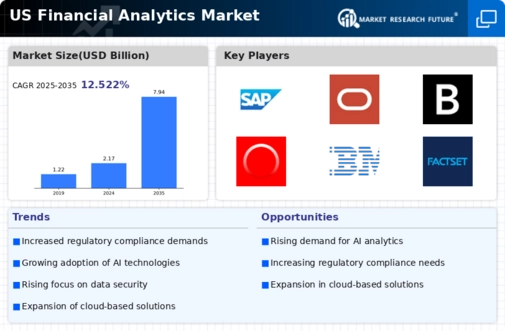The financial analytics market is characterized by a dynamic competitive landscape, driven by the increasing demand for data-driven decision-making and the integration of advanced technologies. Key players such as IBM (US), Oracle (US), and Microsoft (US) are at the forefront, leveraging their extensive resources to innovate and expand their offerings. IBM (US) focuses on artificial intelligence and machine learning capabilities, enhancing its analytics solutions to provide deeper insights. Oracle (US) emphasizes cloud-based solutions, aiming to streamline financial processes and improve operational efficiency. Meanwhile, Microsoft (US) integrates its analytics tools with its broader ecosystem, promoting seamless user experiences across its platforms. Collectively, these strategies foster a competitive environment that prioritizes technological advancement and customer-centric solutions.
In terms of business tactics, companies are increasingly localizing their operations and optimizing supply chains to enhance responsiveness to market demands. The competitive structure of the financial analytics market appears moderately fragmented, with numerous players vying for market share. However, the influence of major companies remains substantial, as they set benchmarks for innovation and service delivery, thereby shaping industry standards.
In November 2025, IBM (US) announced a strategic partnership with a leading fintech firm to enhance its AI-driven analytics capabilities. This collaboration is poised to integrate advanced machine learning algorithms into financial forecasting models, potentially revolutionizing how businesses approach financial planning. The strategic importance of this partnership lies in its ability to provide clients with more accurate and timely insights, thereby improving decision-making processes.
In October 2025, Oracle (US) launched a new suite of cloud-based financial analytics tools designed to cater to small and medium-sized enterprises (SMEs). This initiative reflects Oracle's commitment to democratizing access to advanced analytics, allowing smaller businesses to leverage sophisticated financial insights that were previously accessible only to larger corporations. The launch is significant as it positions Oracle to capture a growing segment of the market that seeks affordable yet powerful analytics solutions.
In September 2025, Microsoft (US) unveiled enhancements to its Power BI platform, incorporating advanced predictive analytics features. This move is indicative of Microsoft's strategy to maintain its competitive edge by continuously evolving its product offerings. The integration of predictive analytics is likely to empower users to make proactive financial decisions, thus reinforcing Microsoft's position as a leader in the financial analytics space.
As of December 2025, current trends in the financial analytics market include a pronounced shift towards digitalization, sustainability, and the integration of artificial intelligence. Strategic alliances are increasingly shaping the competitive landscape, enabling companies to pool resources and expertise to deliver innovative solutions. Looking ahead, competitive differentiation is expected to evolve, with a greater emphasis on innovation and technology rather than price-based competition. Companies that can reliably integrate advanced analytics into their offerings will likely emerge as leaders in this rapidly changing environment.





















Leave a Comment